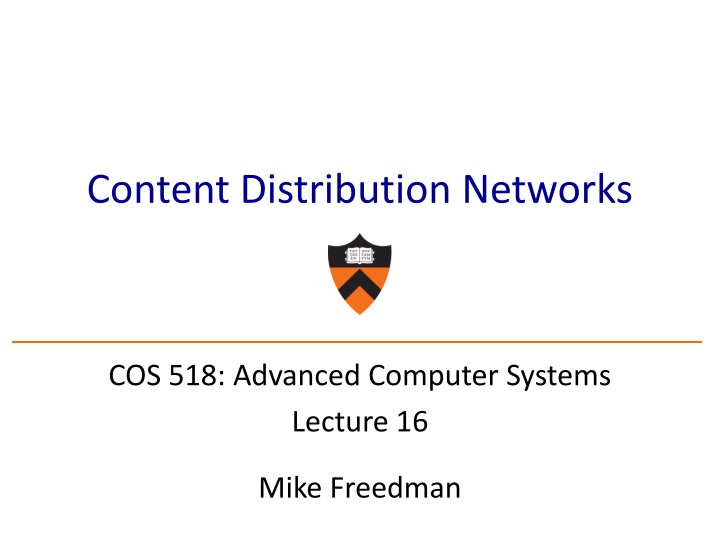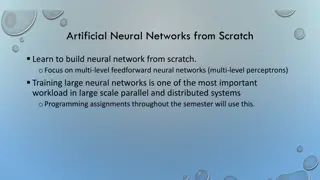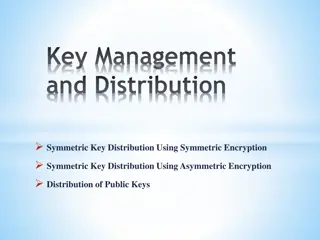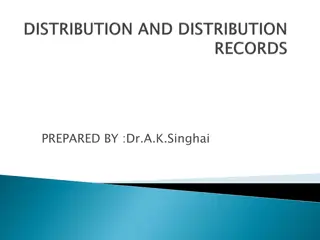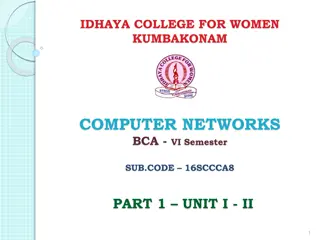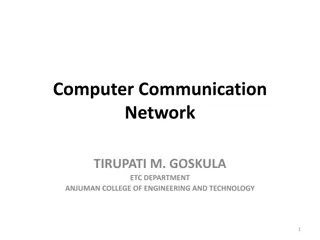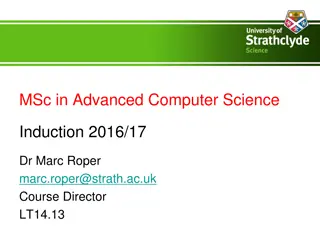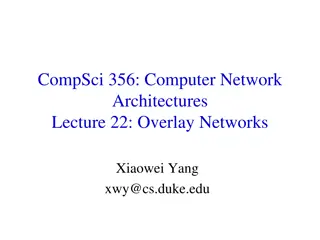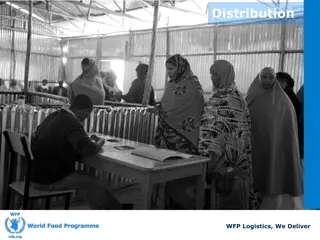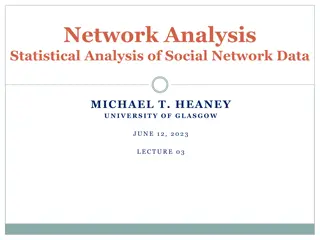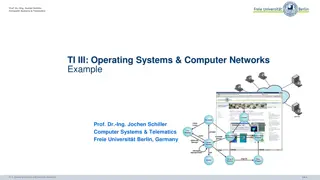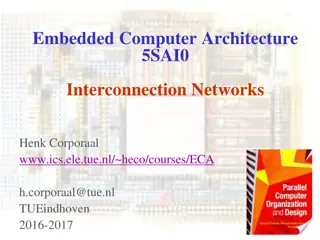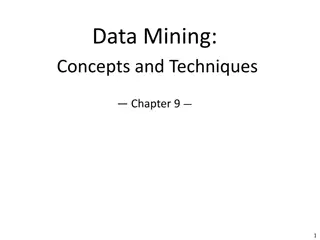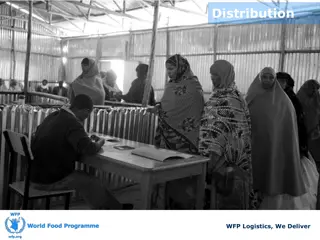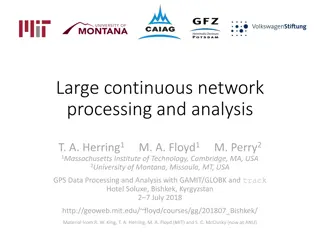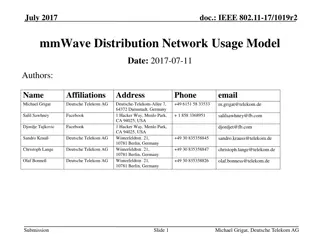Advanced Computer Systems Lecture on Content Distribution Networks
The lecture covers topics such as single server performance issues, skewed popularity of web traffic, web caching, proxy caches, forward and reverse proxies, Google's design of data centers, and limitations of web caching. It discusses the benefits of using proxy caches, intelligent load balancing, and reducing server costs through replicating popular content. The content also highlights the challenges of caching dynamic data and the limitations associated with web caching.
Download Presentation

Please find below an Image/Link to download the presentation.
The content on the website is provided AS IS for your information and personal use only. It may not be sold, licensed, or shared on other websites without obtaining consent from the author.If you encounter any issues during the download, it is possible that the publisher has removed the file from their server.
You are allowed to download the files provided on this website for personal or commercial use, subject to the condition that they are used lawfully. All files are the property of their respective owners.
The content on the website is provided AS IS for your information and personal use only. It may not be sold, licensed, or shared on other websites without obtaining consent from the author.
E N D
Presentation Transcript
Content Distribution Networks COS 518: Advanced Computer Systems Lecture 16 Mike Freedman
Single Server, Poor Performance Single server Single point of failure Easily overloaded Far from most clients Popular content Popular site Flash crowd Denial of Service attack 2
Skewed Popularity of Web Traffic Zipf or power-law distribution Characteristics of WWW Client-based Traces Carlos R. Cunha, Azer Bestavros, Mark E. Crovella, BU-CS-95-01 3
5 Proxy Caches origin server Proxy server client client 5
Forward Proxy Cache close to the client Under administrative control of client-side AS Proxy server client Explicit proxy Requires configuring browser client Implicit proxy Service provider deploys an on path proxy that intercepts and handles Web requests 6
Reverse Proxy origin server Cache close to server Either by proxy run by server or in third-party CDNs Proxy server Directing clients to the proxy Map the site name to the IP address of the proxy origin server 7
Google Design . . . Data Centers Servers Servers Router Router Private Backbone Reverse Proxy Reverse Proxy Internet Requests Client Client Client 8
Proxy Caches (A) Forward (B) Reverse (C) Both (D) Neither Reactively replicates popular content Reduces origin server costs Reduces client ISP costs Intelligent load balancing between origin servers Offload form submissions (POSTs) and user auth Content reassembly or transcoding on behalf of origin Smaller round-trip times to clients Maintain persistent connections to avoid TCP setup delay (handshake, slow start) 9
Limitations of Web Caching Much content is not cacheable Dynamic data: stock prices, scores, web cams CGI scripts: results depend on parameters Cookies: results may depend on passed data SSL: encrypted data is not cacheable Analytics: owner wants to measure hits Stale data Or, overhead of refreshing the cached data 11
Modern HTTP Video-on-Demand Download content manifest from origin server List of video segments belonging to video Each segment 1-2 seconds in length Client can know time offset associated with each Standard naming for different video resolutions and formats: e.g., 320dpi, 720dpi, 1040dpi, Client downloads video segment (at certain resolution) using standard HTTP request. HTTP request can be satisfied by cache: it s a static object Client observes download time vs. segment duration, increases/decreases resolution if appropriate 12
Content Distribution Network origin server in North America Proactive content replication Content provider (e.g., CNN) contracts with a CDN CDN distribution node CDN replicates the content On many servers spread throughout the Internet Updating the replicas Updates pushed to replicas when the content changes CDN server in S. America CDN server in Asia CDN server in Europe 14
Server Selection Policy Live server For availability Lowest load To balance load across the servers Closest Nearest geographically, or in round-trip time Best performance Throughput, latency, Cheapest bandwidth, electricity, Requires continuous monitoring of liveness, load, and performance 15
Server Selection Mechanism Application HTTP redirection Advantages Fine-grain control Selection based on client IP address GET Disadvantages Extra round-trips for TCP connection to server Overhead on the server Redirect GET OK 16
Server Selection Mechanism Advantages No extra round trips Route to nearby server Routing Anycast routing Disadvantages Does not consider network or server load Different packets may go to different servers Used only for simple request-response apps 1.2.3.0/24 1.2.3.0/24 17
Server Selection Mechanism Naming DNS-based server selection 1.2.3.4 DNS query 1.2.3.5 local DNS server 18
A DNS lookup traverses DNS hierarchy . (root) authority 198.41.0.4 edu.: NS 192.5.6.30 com.: NS 158.38.8.133 io.: NS 156.154.100.3 edu. authority 192.5.6.30 princeton.edu.: pedantic.edu.: www.princeton.edu? NS 66.28.0.14 NS 19.31.1.1 Contact 192.5.6.30 for edu. Client Contact 66.28.0.14 for princeton.edu. www.princeton.edu? www.princeton.edu? www.princeton.edu? www.princeton.edu A 140.180.223.42 princeton.edu. authority 66.28.0.14 www.princeton.edu.: A 140.180.223.42 Local nameserver . (root): NS 198.41.0.4 edu.: NS 192.5.6.30 princeton.edu.: NS 66.28.0.14 www.princeton.edu.: A 140.180.223.42 19
DNS caching Performing all these queries takes time And all this before actual communication takes place Caching can greatly reduce overhead Top-level servers very rarely change, popular sites visited often Local DNS server often has information cached How DNS caching works All DNS servers cache responses to queries Responses include a time-to-live (TTL) field, akin to cache expiry 20
Server Selection Mechanism Advantages Avoid TCP set-up delay DNS caching reduces overhead Relatively fine control Naming DNS-based server selection 1.2.3.4 Disadvantage Based on IP address of local DNS server Hidden load effect DNS TTL limits adaptation DNS query 1.2.3.5 local DNS server 21
23 How Akamai Uses DNS cnn.com (content provider) DNS root server GET index. html Akamai cluster Akamai global DNS server 1 2 HTTP HTTP Akamai regional DNS server http://cache.cnn.com/foo.jpg Nearby Akamai cluster end user
24 How Akamai Uses DNS cnn.com (content provider) DNS TLD server DNS lookup cache.cnn.com Akamai cluster Akamai global DNS server 3 1 2 HTTP 4ALIAS: g.akamai.net Akamai regional DNS server Nearby Akamai cluster end user
25 How Akamai Uses DNS cnn.com (content provider) DNS TLD server DNS lookup g.akamai.net Akamai cluster Akamai global DNS server 5 3 1 2 HTTP 6 4 Akamai regional DNS server ALIAS a73.g.akamai.net Nearby Akamai cluster end user
26 How Akamai Uses DNS cnn.com (content provider) DNS TLD server Akamai cluster Akamai global DNS server 5 3 1 2 HTTP 6 4 Akamai regional DNS server 7 8 Address 1.2.3.4 Nearby Akamai cluster end user
27 How Akamai Uses DNS cnn.com (content provider) DNS TLD server Akamai cluster Akamai global DNS server 5 3 1 2 HTTP 6 4 Akamai regional DNS server 7 8 9 Nearby Akamai cluster end user GET /foo.jpg Host: cache.cnn.com
28 How Akamai Uses DNS cnn.com (content provider) DNS TLD server GET foo.jpg 11 12 Akamai cluster Akamai global DNS server 5 3 1 2 HTTP 6 4 Akamai regional DNS server 7 8 9 Nearby Akamai cluster end user GET /foo.jpg Host: cache.cnn.com
29 How Akamai Uses DNS cnn.com (content provider) DNS TLD server 11 12 Akamai cluster Akamai global DNS server 5 3 1 2 HTTP 6 4 Akamai regional DNS server 7 8 9 Nearby Akamai cluster end user 10
30 How Akamai Works: Cache Hit cnn.com (content provider) DNS TLD server Akamai cluster Akamai global DNS server 1 2 HTTP Akamai regional DNS server 3 4 5 Nearby Akamai cluster end user 6
Mapping System Equivalence classes of IP addresses IP addresses experiencing similar performance Quantify how well they connect to each other Collect and combine measurements Ping, traceroute, BGP routes, server logs E.g., over 100 TB of logs per days Network latency, loss, and connectivity 31
Mapping System Map each IP class to a preferred server cluster Based on performance, cluster health, etc. Updated roughly every minute Map client request to a server in the cluster Load balancer selects a specific server E.g., to maximize the cache hit rate 32
Adapting to Failures Failing hard drive on a server Suspends after finishing in progress requests Failed server Another server takes over for the IP address Low-level map updated quickly Failed cluster High-level map updated quickly Failed path to customer s origin server Route packets through an intermediate node 33
Conclusion Content distribution is hard Many, diverse, changing objects Clients distributed all over the world Reducing latency is king Contribution distribution solutions Reactive caching Proactive content distribution networks 34
